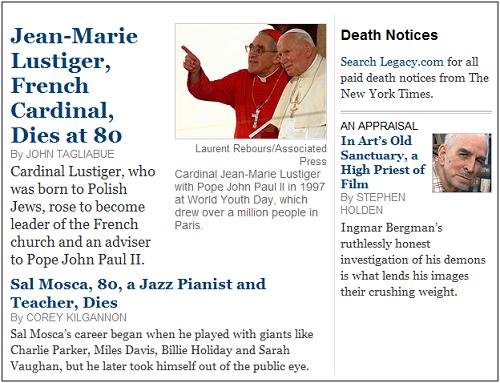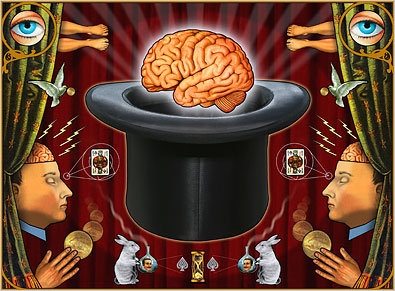Friday, August 31, 2007
Being There
"…it would be quite
a long walk
for him if he had to
walk straight across."

Swiftly Mrs. Who brought
her hands… together.
"Now, you see,"
Mrs. Whatsit said,
"he would be there,
without that long trip.
That is how we travel."

— A Wrinkle in Time,
Chapter 5,
"The Tesseract"
Related material:
To Measure the Changes,
Serious Numbers,
and…
Balls of Fury
Comments Off on Friday August 31, 2007
Friday, August 24, 2007
Comments Off on Friday August 24, 2007
Wednesday, August 22, 2007
Comments Off on Wednesday August 22, 2007
The Enchanted Twilight
The Associated Press
Tuesday, August 21, 2007
GENEVA: British-born author Magdalen Nabb, whose crime novels about a quirky Italian investigator were acclaimed by her idol Georges Simenon, has died, her Swiss publishing house said Tuesday. She was 60.
Nabb, who also wrote stories for children and young adults, died of a stroke on Saturday [August 18, 2007] in Florence, Italy, where she had lived and worked since 1975, said Diogenes Verlag AG of Zurich….
Nabb published 13 books for children and young adults, including “The Enchanted Horse,” “Twilight Ghost” and the “Josie Smith” series about a “girl who always has plenty of ideas.”
Comments Off on Wednesday August 22, 2007
Tuesday, August 21, 2007
Shell Game

Part I:
Overview of Unix
at pangea.stanford.edu
Last revision August 2, 2004
“The Unix operating environment is organized into three layers. The innermost level of Unix is the kernel. This is the actual operating system, a single large program that always resides in memory. Sections of the code in this program are executed on behalf of users to do needed tasks, like access files or terminals. Strictly speaking, the kernel is Unix.
The next level of the Unix environment is composed of programs, commands, and utilities. In Unix, the basic commands like copying or removing files are implemented not as part of the kernel, but as individual programs, no different really from any program you could write. What we think of as the commands and utilities of Unix are simply a set of programs that have become standardized and distributed. There are hundreds of these, plus many additional utilities in the public domain that can be installed.
The final level of the Unix environment, which stands like an umbrella over the others, is the shell. The shell processes your terminal input and starts up the programs that you request. It also allows you to manipulate the environment in which those programs will execute in a way that is transparent to the program. The program can be written to handle standard cases, and then made to handle unusual cases simply by manipulating its environment, without having to have a special version of the program.” (My italics.)
Part II:
Programs
From my paper journal
on the date
“Good Will Hunting”
was released:
|
Friday, December 5, 1997
To: The executive editor, The New York Times
Re: The Front Page/His Girl Friday
Match the speaker with the speech–
|
The Speech—
“The son of a
bitch stole my…” |
|
The Speaker |
Frame of Reference |
| 1. |
rosebud |
A. |
J. Paul Getty |
The front page, N.Y. Times, Monday, 12/1/97 |
| 2. |
clock |
B. |
Joel Silver |
Page 126, The New Yorker, 3/21/94 |
| 3. |
act |
C. |
Blanche DuBois |
The Elysian Fields |
| 4. |
waltz |
D. |
Bob Geldof |
People Weekly 12/8/97 |
| 5. |
temple |
E. |
St. Michael |
Heaven’s Gate |
| 6. |
watch |
F. |
Susanna Moore |
In the Cut (pbk., Dec. ’96) p. 261 |
| 7. |
line |
G. |
Joseph Lelyveld |
Page A21, The New York Times, 12/1/97 |
| 8. |
chair |
H. |
Kylie Minogue |
Page 69, People Weekly, 12/8/97 |
| 9. |
religion |
I. |
Carol Gilligan |
The Garden of Good and Evil |
| 10. |
wife |
J. |
John Travolta |
“Michael,” the movie |
| 11. |
harp |
K. |
Shylock |
Page 40, N.Y. Review of Books, 12/4/97 |
| 12. |
Oscar |
L. |
Stephen King |
The Shining (pbk., 1997), pp. 316, 317 |
Postscript of June 5, 2003:
“…while the scientist sees
everything that happens
in one point of space,
the poet feels
everything that happens
in one point of time…
all forming an
instantaneous and transparent
organism of events….”
— Vladimir Nabokov
Part III:
The Bourne Shell
“The binary program of the Bourne shell or a compatible program is located at /bin/sh on most Unix systems, and is still the default shell for the root superuser on many current Unix implementations.” –Wikipedia
Comments Off on Tuesday August 21, 2007
Comments Off on Tuesday August 21, 2007
Compare
and Contrast

Comments Off on Tuesday August 21, 2007
Monday, August 20, 2007
Comments Off on Monday August 20, 2007
Sunday, August 19, 2007
Symmetry and Mirroring

Logo design by Anton Stankowski
"… at the beginning of the thirties… Stankowski began to work as a typographer and graphic designer in a Zurich advertising agency. Together with a group of friends– they were later to be known as the 'Zurich Concretists'– he explored the possibilities of symmetry and mirroring in the graphic arts. Stankowski experimented with squares and diagonals, making them the hallmarks of his art. Of his now world-famous logo for the Deutsche Bank— the soaring diagonal in the stable square– he proudly said in 1974: 'The company logo is a trade-mark that sends out a signal.'"
"Two New York fire fighters were killed while trying to douse a blaze in the former Deutsche Bank building in the city.
The fire broke out on 14th and 15th floors yesterday afternoon and spread to several floors before it was brought under control about five hours later.
The building had been heavily damaged during the 11 September, 2001 terrorist attacks.
The building, which was damaged by falling debris of the twin towers that had collapsed in 2001 when terrorists flew hijacked planes into them, was being 'deconstructed' to make way for construction of a new Freedom Tower."
Related material
|
SPORTS OF THE TIMES
Restoring the Faith
After Hitting the Bottom
By SELENA ROBERTS
The New York Times
Published: August 1, 2007
What good is a nadir if it's denied or ignored? What's the value of reaching the lowest of the low if it can't buy a cheap epiphany?
|

When you care enough
to send the very best…
Comments Off on Sunday August 19, 2007
Saturday, August 18, 2007
“In chapters 19 and 20 of LILA there is a discussion about the possibility of making Zen and the Art into a movie. It opens with a scene where Robert Redford, who ‘really would like to have the film rights,’ comes to meet and negotiate with Phaedrus in his New York City hotel room. Phaedrus tells the famous actor that he can have the rights to the book, but maybe that’s just because he’s star-struck and doesn’t like to haggle. Under his excitement, Phaedrus has a bad feeling about it. He tells us that he’s been warned by several different people not to allow such a film to be made. Even Redford warned him not to do it. So what’s the problem? As it’s put at the end of that discussion, ‘Films are social media; his book was largely intellectual. That was the center of the problem.'”
— David Buchanan at robertpirsig.org
“The insight is constituted precisely by ‘seeing’ the idea in the image, the intelligible in the sensible, the universal in the particular, the abstract in the concrete.”
— Fr. Brian Cronin‘s Foundations of Philosophy, Ch. 2, “Identifying Direct Insights,” quoted in Ideas and Art
See also Smiles of a Summer Evening, the current issue of TIME, the time of this entry (7:20:11 PM ET), and Plato, Pegasus, and the Evening Star.
Comments Off on Saturday August 18, 2007
Comments Off on Saturday August 18, 2007
Comments Off on Saturday August 18, 2007
Tuesday, August 14, 2007
Philip K. Dick,
1928 – 1982
on the cover of
a 1987 edition of
his 1959 novel
Time Out of Joint:

Cover art by Barclay Shaw reprinted
from an earlier (1984) edition
Philip K. Dick as a
window wraith (see below)
The above illustration was suggested by yesterday's quoted
New Yorker characterization by Adam Gopnik of Philip K. Dick–
"… the kind of guy who can't drink one cup of coffee without drinking six, and then stays up all night to tell you what Schopenhauer really said and how it affects your understanding of Hitchcock and what that had to do with Christopher Marlowe."
— as well as by the illustrations of Gopnik's characterization in Kernel of Eternity, and by the following passage from Gopnik's 2005 novel The King in the Window:
"What's a window wraith?"
"It's someone who once lived in the ordinary world who lives now in a window, and makes reflections of the people who pass by and look in."
"You mean you are a ghost?!" Oliver asked, suddenly feeling a little terrified.
"Just the opposite, actually. You see, ghosts come from another world and haunt you, but window wraiths are the world. We're the memory of the world. We're here for good. You're the ones who come and go like ghosts. You haunt us."
Related material: As noted, Kernel of Eternity, and also John Tierney's piece on simulated reality in last night's online New York Times. Whether our everyday reality is merely a simulation has long been a theme (as in Dick's novel above) of speculative fiction. Interest in this theme is widespread, perhaps partly because we do exist as simulations– in the minds of other people. These simulations may be accurate or may be– as is perhaps Gopnik's characterization of Philip K. Dick– inaccurate. The accuracy of the simulations is seldom of interest to the simulator, but often of considerable interest to the simulatee.
The cover of the Aug. 20 New Yorker in which the Adam Gopnik essay appears may also be of interest, in view of the material on diagonals in the Log24 entries of Aug. 1 linked to in yesterday's entry:

"Summer Reading,"
by Joost Swarte
Comments Off on Tuesday August 14, 2007
Monday, August 13, 2007
Adam Gopnik in
The New Yorker of
August 20, 2007–
On Philip K. Dick:
"… the kind of guy who can't drink one cup of coffee without drinking six, and then stays up all night to tell you what Schopenhauer really said and how it affects your understanding of Hitchcock and what that had to do with Christopher Marlowe."
Modernity: A Film by
Alfred Hitchcock:
"… the most thoroughgoing modernist design element in Hitchcock's films arises out of geometry, as Francois Regnault has argued, identifying 'a global movement for each one, or a "principal geometric or dynamic form," which can appear in the pure state in the credits….'" –Peter J. Hutchings (my italics)
More >>
Epilogue:
Adam Gopnik is also the author
of The King in the Window, a tale
of the Christian feast of Epiphany
and a sinister quantum computer.
For more on Epiphany, see
the Log24 entries of August 1.
For more on quantum computing,
see What is Quantum Computation?.
See also
the previous entry.
Comments Off on Monday August 13, 2007
Sunday, August 12, 2007
In the context of quantum information theory, the following structure seems to be of interest–
"… the full two-by-two matrix ring with entries in GF(2), M2(GF(2))– the unique simple non-commutative ring of order 16 featuring six units (invertible elements) and ten zero-divisors."
— "Geometry of Two-Qubits," by Metod Saniga (pdf, 17 pp.), Jan. 25, 2007
This ring is another way of looking at the 16 elements of the affine space A4(GF(2)) over the 2-element field. (Arrange the four coordinates of each element– 1's and 0's– into a square instead of a straight line, and regard the resulting squares as matrices.) (For more on A4(GF(2)), see Finite Relativity and related notes at Finite Geometry of the Square and Cube.) Using the above ring, Saniga constructs a system of 35 objects (not unlike the 35 lines of the finite geometry PG(3,2)) that he calls a "projective line" over the ring. This system of 35 objects has a subconfiguration isomorphic to the (2,2) generalized quadrangle W2 (which occurs naturally as a subconfiguration of PG(3,2)– see Inscapes.)
Saniga concludes:
"We have demonstrated that the basic properties of a system of two interacting spin-1/2 particles are uniquely embodied in the (sub)geometry of a particular projective line, found to be equivalent to the generalized quadrangle of order two. As such systems are the simplest ones exhibiting phenomena like quantum entanglement and quantum non-locality and play, therefore, a crucial role in numerous applications like quantum cryptography, quantum coding, quantum cloning/teleportation and/or quantum computing to mention the most salient ones, our discovery thus
-
not only offers a principally new geometrically-underlined insight into their intrinsic nature,
-
but also gives their applications a wholly new perspective
-
and opens up rather unexpected vistas for an algebraic geometrical modelling of their higher-dimensional counterparts."
is not without relevance to
the physics of quantum theory.
Comments Off on Sunday August 12, 2007
Saturday, August 11, 2007
Four Colours
The previous entry dealt with Plato’s myth of the ring of Gyges that conferred invisibility. Another legendary ring, from Hermann Hesse, with some background from Carl Jung:
From C. G. Jung, Collected Works (Princeton U. Press), Volume 12– Psychology and Alchemy (1944)– Part II– “Individual Dream Symbolism in Relation to Alchemy”– Chapter 3, “The Symbolism of the Mandala”– as quoted in Jung, Dreams, published by Routledge, 2001– Page 265–
“… the dreamer is wandering about in a dark cave, where a battle is going on between good and evil. But there is also a prince who knows everything. He gives the dreamer a ring set with a diamond….
Visual impression (waking dream):
The dreamer is falling into the abyss. At the bottom there is a bear whose eyes gleam alternately in four colours: red, yellow, green, and blue. Actually it has four eyes that change into four lights. The bear disappears and the dreamer goes through a long dark tunnel. Light is shimmering at the far end. A treasure is there, and on top of it the ring with the diamond. It is said that this ring will lead him on a long journey to the east.”
Hermann Hesse, The Journey to the East (1932):
“‘… Despair is the result of each earnest attempt to go through life with virtue, justice, and understanding and to fulfil their requirements. Children live on one side of despair, the awakened on the other side. Defendant H. is no longer a child and is not yet fully awakened. He is still in the midst of despair. He will overcome it and thereby go through his second novitiate. We welcome him anew into the League, the meaning of which he no longer claims to understand. We give back to him his lost ring, which the servant Leo has kept for him.’
The Speaker then brought the ring, kissed me on the cheek and placed the ring on my finger. Hardly had I looked at the ring, hardly had I felt its metallic coolness on my fingers, when a thousand things occurred to me, a thousand inconceivable acts of neglect. Above all, it occurred to me that the ring had four stones at equal distances apart, and that it was a rule of the League and part of the vow to turn the ring slowly on the finger at least once a day, and at each of the four stones to bring to mind one of the four basic precepts of the vow. I had not only lost the ring and had not once missed it, but during all those dreadful years I had also no longer repeated the four basic precepts or thought of them. Immediately, I tried to say them again inwardly. I had an idea what they were, they were still within me, they belonged to me as does a name which one will remember in a moment but at that particular moment cannot be recalled. No, it remained silent within me, I could not repeat the rules, I had forgotten the wording. I had forgotten the rules; for many years I had not repeated them, for many years I had not observed them and held them sacred– and yet I had considered myself a loyal League brother.
The Speaker patted my arm kindly when he observed my dismay and deep shame.”
Comments Off on Saturday August 11, 2007
Friday, August 10, 2007
The Ring of Gyges
10:31:32 AM ET
Commentary by Richard Wilhelm
on I Ching Hexagram 32:
“Duration is… not a state of rest, for mere standstill is regression.
Duration is rather the self-contained and therefore self-renewing
movement of an organized, firmly integrated whole, taking place in
accordance with immutable laws and beginning anew at every ending.”
Related material

Jung and the Imago Dei
“Not Being There,”
by Christopher Caldwell,
from next Sunday’s
New York Times Magazine:
| “The chance to try on fresh identities was the great boon that life online was supposed to afford us. Multiuser role-playing games and discussion groups would be venues for living out fantasies. Shielded by anonymity, everyone could now pass a ‘second life’ online as Thor the Motorcycle Sex God or the Sage of Wherever. Some warned, though, that there were other possibilities. The Stanford Internet expert Lawrence Lessig likened online anonymity to the ring of invisibility that surrounds the shepherd Gyges in one of Plato’s dialogues. Under such circumstances, Plato feared, no one is ‘of such an iron nature that he would stand fast in justice.’Time, along with a string of sock-puppet scandals, has proved Lessig and Plato right.” |
“The Boy Who Lived,”
by Christopher Hitchens,
from next Sunday’s
New York Times Book Review:
| On the conclusion of the Harry Potter series:”The toys have been put firmly back in the box, the wand has been folded up, and the conjuror is discreetly accepting payment while the children clamor for fresh entertainments. (I recommend that they graduate to Philip Pullman, whose daemon scheme is finer than any patronus.)” |
I, on the other hand,
recommend Tolkien…
or, for those who are
already familiar with
Tolkien, Plato– to whom
“The Ring of Gyges” may
serve as an introduction.
“It’s all in Plato, all in Plato:
bless me, what do they
teach them at these schools!”
— C. S. Lewis
Comments Off on Friday August 10, 2007
Thursday, August 9, 2007
Bulletin of the American Mathematical Society,
Volume 31, Number 1, July 1994, Pages 1-14
Selberg’s Conjectures
and Artin L-Functions (pdf)
M. Ram Murty
Introduction
In its comprehensive form, an identity between an automorphic L-function and a “motivic” L-function is called a reciprocity law. The celebrated Artin reciprocity law is perhaps the fundamental example. The conjecture of Shimura-Taniyama that every elliptic curve over Q is “modular” is certainly the most intriguing reciprocity conjecture of our time. The “Himalayan peaks” that hold the secrets of these nonabelian reciprocity laws challenge humanity, and, with the visionary Langlands program, we have mapped out before us one means of ascent to those lofty peaks. The recent work of Wiles suggests that an important case (the semistable case) of the Shimura-Taniyama conjecture is on the horizon and perhaps this is another means of ascent. In either case, a long journey is predicted…. At the 1989 Amalfi meeting, Selberg [S] announced a series of conjectures which looks like another approach to the summit. Alas, neither path seems the easier climb….
[S] A. Selberg, Old and new
conjectures and results
about a class of Dirichlet series,
Collected Papers, Volume II,
Springer-Verlag, 1991, pp. 47-63.
Zentralblatt MATH Database on the above Selberg paper:
“These are notes of lectures presented at the Amalfi Conference on Number Theory, 1989…. There are various stimulating conjectures (which are related to several other conjectures like the Sato-Tate conjecture, Langlands conjectures, Riemann conjecture…)…. Concluding remark of the author: ‘A more complete account with proofs is under preparation and will in time appear elsewhere.'”
Related material: Previous entry.
Comments Off on Thursday August 9, 2007
Tuesday, August 7, 2007
In memory of
Atle Selberg, mathematician,
dead at 90 on August 6, 2007
According to the
American Mathematical Society,
Selberg died, like André Weil, on
the Feast of the Metamorphosis.
Endgame

Metaphor for Morphean morphosis,
Dreams that wake, transform, and die,
Calm and lucid this psychosis,
Joyce's nightmare in Escher's eye.
— Steven H. Cullinane, Nov. 7, 1986
Read more.
For further views of
the Amalfi coast, site of
the above Escher scene,
see the film "A Good Woman"
(made in 2004, released in 2006)
starring Scarlett Johansson–

Scene from "A Good Woman"
— and the following from
Collegiate Church of
St. Mary Magdalene,
Atrani, Amalfi Coast, Italy:
"An interior made exterior"
— Wallace Stevens
Comments Off on Tuesday August 7, 2007
The Horse Whisperer

Scarlett Johansson and friend
in “The Horse Whisperer” (1998)
Thanks to
University Diaries (Aug. 6) for the following:
“‘The University of Sydney has ordered an independent review into allegations that the dean of the Conservatorium of Music hired a horse whisperer to conduct management workshops.’ [Are you, like UD, a bit vague on exactly what a horse whisperer is? And are you having trouble figuring out what a horse whisperer would have to offer a management workshop? But then, what exactly is a management workshop? Read on.]”
For some background on horse whispering and management workshops, see IABC Steal Sheet, March 2004.
Related material:
The recent Log24 entries
Putting Descartes Before Dehors
 
“Descartes déclare que
c’est en moi, non hors de moi,
en moi, non dans le monde,
que je pourrais voir
si quelque chose existe
hors de moi.”
— ATRIUM, Philosophie
For further details,
see ART WARS.
|
Comments Off on Tuesday August 7, 2007
Monday, August 6, 2007
|
The Place of the Lion, by Charles Williams, 1931, Chapter Eight:
"Besides, if this fellow were right, what harm would the Divine Universals do us? I mean, aren't the angels supposed to be rather gentle and helpful and all that?"
"You're doing what Marcellus warned you against… judging them by English pictures. All nightgowns and body and a kind of flacculent sweetness. As in cemeteries, with broken bits of marble. These are Angels– not a bit the same thing. These are the principles of the tiger and the volcano and the flaming suns of space."
Under the Volcano, Chapter Two:
"But if you look at that sunlight there, then perhaps you'll get the answer, see, look at the way it falls through the window: what beauty can compare to that of a cantina in the early morning? Your volcanoes outside? Your stars– Ras Algethi? Antares raging south southeast? Forgive me, no."
A Spanish-English dictionary:
lucero m.
morning or evening star:
any bright star….
hole in a window panel
for the admission of light….
Look at the way it
falls through the window….
— Malcolm Lowry
How art thou fallen from heaven,
O Lucifer, son of the morning!
— Isaiah 14:12
For more on Spanish
and the evening star,
see Plato, Pegasus, and
the Evening Star.
|
Symmetry axes
of the square:

(See Damnation Morning.)
From the cover of the
Martin Cruz Smith novel
Stallion Gate:

"That old Jew
gave me this here."
— Dialogue from the
Robert Stone novel
A Flag for Sunrise.
Related material:
A Mass for Lucero,
Log24, Sept. 13, 2006—

— and this morning's online
New York Times obituaries:

The above image contains summary obituaries for Cardinal Lustiger, Archbishop of Paris, 1981-2005, and for Sal Mosca, jazz pianist and teacher. In memory of the former, see all of the remarks preceding the image above. In memory of the latter, the remarks of a character in Martin Cruz Smith's Stallion Gate on jazz piano may have some relevance:
"I hate arguments. I'm a coward. Arguments are full of words, and each person is sure he's the only one who knows what the words mean. Each word is a basket of eels, as far as I'm concerned. Everybody gets to grab just one eel and that's his interpretation and he'll fight to the death for it…. Which is why I love music. You hit a C and it's a C and that's all it is. Like speaking clearly for the first time. Like being intelligent. Like understanding. A Mozart or an Art Tatum sits at the piano and picks out the undeniable truth."
Comments Off on Monday August 6, 2007
Comments Off on Monday August 6, 2007
Sunday, August 5, 2007
Lucero
“What have I got out of my life? Contacts with famous men… The occasion Einstein asked me the time, for instance. That summer evening…. smiles when I say I don’t know. And yet asked me. Yes: the great Jew, who has upset the whole world’s notions of time and space, once leaned down… to ask me… ragged freshman… at the first approach of the evening star, the time. And smiled again when I pointed out the clock neither of us had noticed.”
To Ride Pegasus, by Anne McCaffrey, 1973:
“Mary-Molly luv, it’s going to be accomplished in steps, this establishment of the Talented in the scheme of things. Not society, mind you, for we’re the original nonconformists…. and Society will never permit us to integrate. That’s okay!” He consigned Society to insignificance with a flick of his fingers. “The Talented form their own society and that’s as it should be: birds of a feather. No, not birds. Winged horses! Ha! Yes, indeed. Pegasus… the poetic winged horse of flights of fancy. A bloody good symbol for us. You’d see a lot from the back of a winged horse…”
From Holt Spanish and English Dictionary, 1955:
lucero m Venus
(as morning or evening star);
bright star…
star (in forehead of animal)….

Scarlett Johansson and friend
in “The Horse Whisperer” (1998)
Comments Off on Sunday August 5, 2007
Comments Off on Sunday August 5, 2007
Saturday, August 4, 2007
Comments Off on Saturday August 4, 2007
Comments Off on Saturday August 4, 2007
Law and Poetry

Robert Duvall and John Travolta
This entry is in memory of Robert E. Keeton, a “judge’s judge” who is the subject of an obituary in today’s New York Times. Judge Keeton died, according to the Times, on July 1. According to Harvard Law School, the University of Texas Law School, and The Boston Globe, he died on July 2. Such details can sometimes be important.
Comments Off on Saturday August 4, 2007
Friday, August 3, 2007
From August 1 —
| SPORTS OF THE TIMES
Restoring the Faith
After Hitting the Bottom
By SELENA ROBERTS
The New York Times
Published: August 1, 2007
What good is a nadir if it’s denied or ignored? What’s the value of reaching the lowest of the low if it can’t buy a cheap epiphany? |
The following image
represents an epiphany
of sorts:
It contains the
“double cross” symbol
of Fritz Leiber’s
Changewar stories;
the “double cross” is
also the traditional
eight-ray symbol of
the evening star–
the planet Venus.
Epiphanies due to Venus
are indeed sometimes
cheap… but not always.
For further details, see
and
Comments Off on Friday August 3, 2007
Comments Off on Friday August 3, 2007
Every Picture
Tells a Story

New York Times online, August 3, 2007
As does Kevin Cullen —
"Tommy Makem was
an Irish soul singer,
and souls don't die."
Cullen's statement
in picture form:
E is for Everlast

Scene from "Million Dollar Baby"
Log24 on July 30, 2005
Comments Off on Friday August 3, 2007
Wednesday, August 1, 2007
“Let’s give ’em somethin’ to talk about,
A little mystery to figure out”
(Scarlett Johansson singing on
Saturday Night Live, April 21, 2007)
A Midrash for Sid

Scene from “Scoop” (2006)
Clues:
Today’s previous entries,
Show Business
according to Fritz Leiber:
“Sid thinks you’re ready for
some of the smaller parts,”
April 22, 2007, 11:09 AM:
Teaching a Brick to Sing,
April 22, 2007, 8:31 PM:
Welcome to the Cave,
and, in conclusion…
Shadows in the Cave–
Today’s Pennsylvania lottery

and a midrash on
today’s lottery:
527 —
5/27, 2005:
Drama of the Diagonal,
Part Deux
and 168 —
December 25, 2005:
The Beauty of Klein’s
Simple Group
(of order 168).
Comments Off on Wednesday August 1, 2007
Comments Off on Wednesday August 1, 2007
Comments Off on Wednesday August 1, 2007
August First,
8:00:14 AM:
Cheap Epiphany
|
SPORTS OF THE TIMES
Restoring the Faith
After Hitting the Bottom
By SELENA ROBERTS
The New York Times
Published: August 1, 2007
What good is a nadir if it's denied or ignored? What's the value of reaching the lowest of the low if it can't buy a cheap epiphany?
|
Pennsylvania Lottery
on the Feast of
St. Ignatius Loyola:
|

|

|
Restoring the Booze:
A Look at the 50's-

Another Epiphany:

Box-style I Ching, January 6, 1989
(Click on image for background.)
Detail:

Related material:
Logos and Logic
and Diagon Alley.
"What a swell
party this is."
— adapted from
Cole Porter
Comments Off on Wednesday August 1, 2007












































